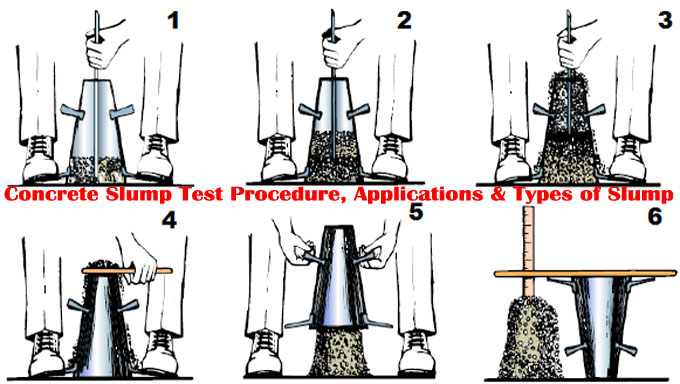
The slump test procedure for concrete and applications

The slump test is a very easy method to perform. This method is not suitable for either very dry or very wet concrete. It is used as a control test to indicate the uniformity of the concrete from batch to batch. This test is taken because to test the workability of the concrete. It is also shown that which concrete slumps.
Workability of Concrete
The workability of concrete defines that by which things the concrete can be mixed, transported, and placed in the right position. It depends upon some things like the quantity of water, aggregate grade, and percentage of fine materials in the mix. There are few tests that provide the workability of concrete. The following tests are:
1. Slump test.
2. Compaction factor test.
3. Flow test.
4. Kelly ball test.
5. Vee-Bee consistometer test.
6. K-Slump Test.
The slump test is generally happened in sites and labs due to the ease and results. It provides very quick results. Compared to others slump test is the best among all.
The Procedure of Slump Test
Users first have to clean the inner surface of the Frustum cone. It must be free from any kind of moisture content and any old set concrete. After that users have to place the cone on the metallic steel plate. Next, they have to fill the cone with the concrete in four layers with the height of ? of the cone.
Tamping rod tampe every layer 25 times. For distributing the strokes over the cross-section. After filling the 4th layer users have to strike off the concrete with the trowel.
After that users have to remove the cone from the concrete in a vertical direction. They also raise the concrete very slowly. At last, it allows the concrete to subside. This subsidence is known as SLUMP.
The Outcome
Now users have to measure the height of the cone and the highest point of the slump test in mm. The difference between the Height of the cone and the highest point of the Subside provides the users the Slump value.
The values of Slump Tests for various Concrete Mixes
| Concrete Mixes | Slump range in mm |
| Columns, Retaining walls | 75-150mm |
| Beams & Slabs | 50-100mm |
| CC Pavements | 20-30mm |
| Decks of bridge | 30-75mm |
| Vibrated Concrete | 12-25mm |
| Huge Mass constructions | 25-50mm |
Types of Slump
True Slump
If this type of slump forms a shape the same as a cone then it is called a true slump.
Shear Slump
If half of the slump is slid down then it is known as Shear Slump. By forming this shape it is proven that the concrete has features of segregation.
Collapse Slump
If the whole slump goes in all directions and does not form the shape of a cone, then it is called a collapse slump. This shape is formed by adding excessive water in concrete to increase the workability.
Zero Slump
This type of slump is not perfect for too dry and stiff concrete. Very dry and stiff concrete does not form any shape like the cone after removing it.
Advantages of Slump Tests
1. This type of test can be performed only in sites and labs.
2. This type of test takes less time compared to other tests.
3. The slump test provides very quick results among other tests.
Wrap up
In this article, we discussed the slump test, the workability of concrete, the few same tests like slump test, the procedure of slump test, the values of slump test, types of slump test, and advantages of slump test.
If readers like this article please share your comments with us. You can write down comments in the comment box below the article.


